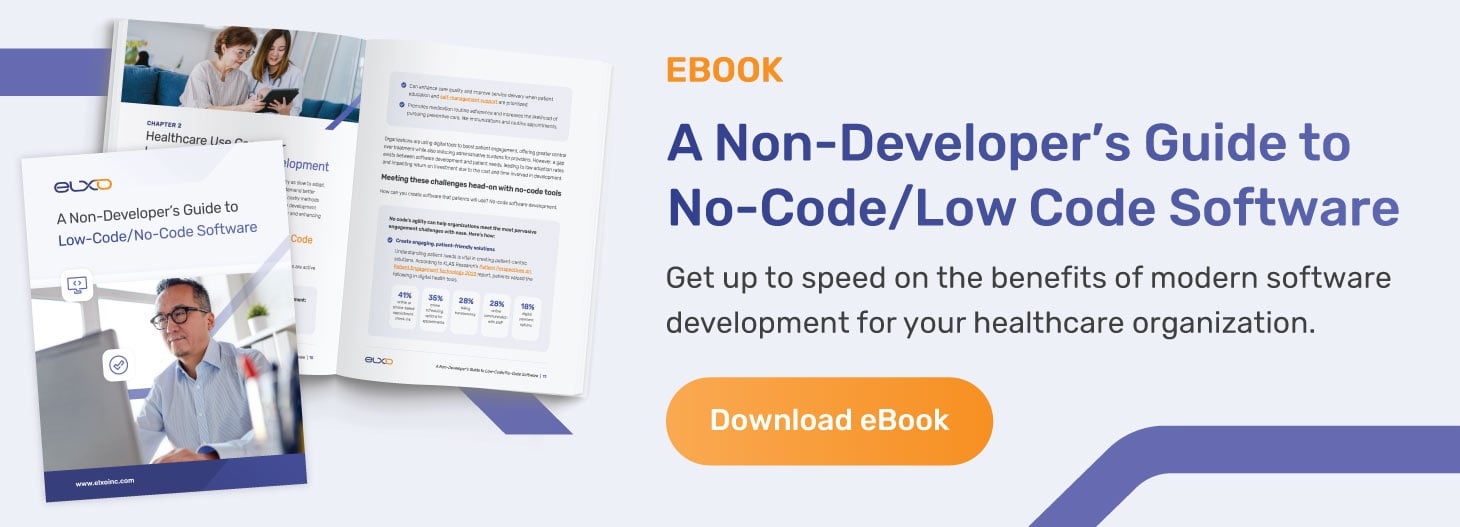When it comes to software, healthcare organizations are faced with complex needs. They must keep pace with technological advancements, meet rising patient, clinician, and staff expectations, support their teams with multifaceted tooling, and more. But buying software out of the box often isn’t enough to meet those diverse needs, and building software takes time, money, and a team of experienced developers.
Low-code no-code platforms are providing new paths forward for organizations looking to build effective software. According to Grand View Research, the low-code platform market is projected to grow at a compound annual growth rate of 22.5% through 2030. This growth is being driven by the versatile nature of these platforms, which can help make software development scalable, agile, and user-friendly.
But what are the requirements for these different development models? Is it worth taking on the burden of development alone, or should you partner with a vendor? Let’s explore how to decide what’s right for your organization and how to identify the right partner for your development journey.
Examining the resources required for internal development
Generally, there are three primary areas to consider when assessing your organization’s capacity for developing new software: technical expertise, budget, and time.
- With conventional development, you typically need a full team of developers with extensive coding experience. Stakeholders across the organization will have to summarize what they need from the software, and developers will translate that vision and begin manually writing the code line by line. This ground-up development nets you the most customizability, but because of the talent, work, and maintenance required, it costs the most and takes the longest.
- With low-code development, there’s usually much less hands-on coding. The foundation for the software is already built, allowing you to drag-and-drop features into place, but there’s space to manually expand on those features. As a result, you won’t need a full team of low-code developers, and the ones you do employ won’t need quite as extensive coding experience. Because low code requires fewer programming skills and enables you to deploy applications quicker, this method is much less expensive and time intensive.
- With no-code development, no programming or coding skills are required. Everyday users and healthcare stakeholders can partake in designing and building the software thanks to the purely visual interface. Because everything is pre-configured, you can’t tweak or add code, so there’s a lack of flexibility in that sense, but the closed system allows for rapid changes to be deployed and requires little maintenance. Those trade-offs result in the least expensive and fastest development.
By understanding what resources are available to your organization based on these three categories, you can get a better grasp of what development model will suit your needs.
The difference low-code vendors or a no-code agency can make
Whether you have a vision of what you want in an application or don’t know where to start, partnering with a consultancy can help. They can provide a network of support and expertise to fall back on, ensure development stays on track, handle ongoing maintenance, and more.
Think of it like this: How much do you want to take off your staff’s plate? The more involved your team is, the higher the operational cost will be, and more resources will need to be dedicated to development and maintenance. When you partner with a low-code developer, a no-code agency, or a consultancy for a fully custom build, you can offload most of the workload by relying on their expertise.
Ultimately, vendors understand their low-code no-code platforms better than anyone. Leaning on that knowledge enables them to focus on what they do best — building seamless user experiences — so your clinicians can focus on spending more time with patients and making better-informed clinical decisions, and your leaders can better optimize staff resources and move higher-value, more strategic tasks forward.
Working with low-code vendors or a no-code agency can make a big difference, but to ensure maximum impact, you need to find the right partner.
How to find the perfect partner
Choosing a partner can be a complex process all on its own — it takes more than simply comparing costs, but understanding the quality of the software they develop as well.
According to a Health Systems (Basingstoke) assessment, there’s a critical need to validate and verify software quality in the healthcare space. Malfunctions and erroneous calculations can negatively impact clinical decision-making, open up sensitive data to security risk, constrain performance, and more. When human lives and the quality and speed of care are on the line, it’s vital to find the ideal software fit.
To understand the true value a partner can bring to the table, you must measure their commitment to software quality by vetting their capabilities and asking the right questions.
Assess vendor capabilities
Here’s what to look for when vetting a vendor’s capabilities:
- Technical specifications. Interoperability is critical in healthcare to ensure all systems work together, from electronic health records (EHRs) to patient portals and beyond. Make sure the vendors you consider have compatible tech stacks, build in the same programming languages, and integrate with your existing solutions.
- A dedication to patient-centric care. Pay attention to how vendors communicate their commitment to patients. Do they emphasize patient-friendly tools and simplified but empowering patient experiences? The patient should always be at the center of everything.
- Experience. Investigate their prior work and background. How many integrations have they done? How long have they been in business? More experience often translates to smoother development and integration processes.
- Security certifications. Sensitive patient data and strict healthcare regulations require adherence to the highest security standards and the most robust data privacy policies. Be sure to assess how stringently vendors follow these regulations and the certifications they hold.
- Case studies. Look for case studies featuring organizations in the same industry and of comparable size to your own to see how vendors have met comparable needs in the past.
- Consultative services. Some vendors only offer low-code no-code platforms, while others can share their expertise and provide consultation to help solve even the toughest challenges. Consider whether you require an objective, third-party review of your needs before getting started on development.
It’s also wise to make a list of must-have features, preferred capabilities, and other priorities in your software to help narrow down the playing field. And keep the future in mind, too — you may not need certain features today, but what about in the long term? You want a vendor that can grow with you.
Ask the right questions
Here are some important questions to ask vendors:
- How do you approach collaboration? What is the best way to reach your team for support? How can we provide constructive feedback?
- How rapidly can you help design, build, integrate, and deploy the software? What does an estimated timeline look like? What milestones should we plan to hit and when?
- How scalable are your low-code no-code platforms? Is there room for on-the-fly adjustments or future expansions? How do you keep pace with advancements in the industry?
- What is the end-user learning curve for your software? How soon can providers and patients get up and running? How much training or onboarding is required?
- How reliable is the software? What uptime rates do you aim to uphold? What type of maintenance do you perform and how often?
- What are the safety considerations for the software? What types of security and encryption measures are in place? Can you help ensure data governance and privacy?
- What’s the best cost quote or estimate you can provide? Are there any additional or ongoing fees beyond initial purchase that may impact long-term costs?
In a complicated healthcare landscape, it can feel overwhelming to go it alone and build a solution that solves all your needs, but it doesn’t have to be that way. By asking the right questions, you can find a partner who listens and understands your needs. That trust is critical to standing up the software your patients and providers demand — with plenty of room to grow, flex, and scale as their needs evolve.
Looking for a collaborative healthcare consulting partner? Get started with Elxo today — we’re happy to set up a no-obligation discussion to help build a just-right solution for your organization.






